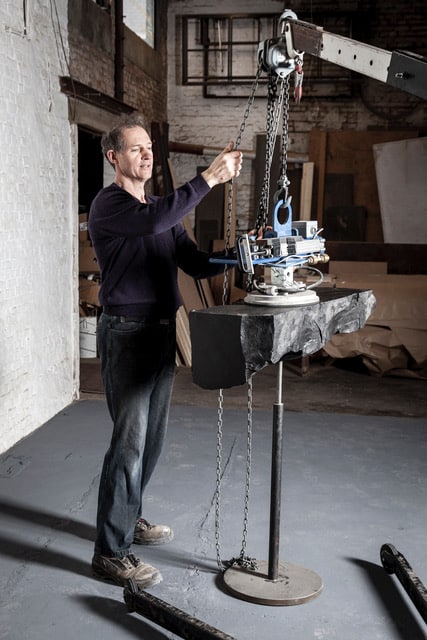
Gerard Kuijpers
1. Where were you born and where are you from ?
I was born in Mechelen ( Belgium), then lived in various places in Flanders and now I live and work in Mechelen again.
2. What is your first memory connected to the art world ?
A modernist building across the apartment of my grandparents is my earliest memory.
3. Have you always worked in the art/design field ?
I started at the age of 22 as an autodidact. When I was younger I wanted to be a writer. I published a few pages of proza in 2 literary magazines.
4. What led you to the design creation ?
I needed a barstool in my apartment but couldn’t buy one, so I tried to create one. Actually the Zigzag Chair was the first object I created and made as well.
5. How would you describe your creative process and it influences ?
What triggers me most in starting a new piece is the desire to find a new way of making the construction, for a table or console for example. How to make a solid and elegant junction between vertical and horizontal parts. Friction between materials is the key ingredient to make a new object. Secondly a bizarre or monumental piece of stone can urge me to give it a certain function in a new design.
6. Could you describe a typical day of your work ?
A few times I dreamt about a very precise object . Sometimes I am tempted to improve earlier work. But mostly I want to experiment on something new. Then I start to visualize a construction while trying to feel its energy in real space. Vertical and horizontal parts work together or are on the contrary opposed to each other. I always try to link them without destroying their initial qualities.
Visualization has the advantage to drawing not to loose contact with the 3D-object while I want to clear out some details of the construction. See it as a cameraman zooming in on a particular part without loosing the overview.
Then I check the dimensions and the strongness of some steel bars or tubes that I find in my studio before I decide which one to use.
That is one way to start creating. Another way is that I walk along in my studio when suddenly a special rock or boulder gets my attention. Next I try to make something with it in order to emphasize its beauty and uniqueness, while at the same time adding a function. A functional object has the added value that the owner can build a tactile relationship with it by touching and using it. Doing so it gets alive.
7. Why did you choose the specific materials you work with ?
With steel I can make constructions that are elegant and solid at the same time. Dimensions can be reduced without diminishing stability. So, often people tell me that my work give the impression being light while the real weight can be enormous. Secondly I like to work with rough pieces of stone because they are relicts from ancient times and are created in millions of years.

8. What are the technical particularities of your creations ?
It’s all about gravity! Each object is an attempt to deceive gravity in an original way.
But weight is also a value. Sometimes the weight of a massive block of stone makes a construction more stable. One time I used the weight of a thick tabletop in wood to keep the legs in position.
Important is that one can disassemble the final object again. I use welding only minimal. Mostly bolts and nuts are the way of fixation.
9. What advices could you give to beginning artists who would like to create sculptural design works ?
Try to find your personal approach to materials and construction. Look for the boundaries and go beyond. Try to find the virtue of failure, because it means that you have been taking risks. Find also the energy to start again from scratch when necessary.
10. If your works had to belong to a design movement, in which one would you define it ?
Brutalism
11. What designers have influenced you ?
Paul Gees, Belgian artist who uses the flexibility of wood to keep little stones in position.
Richard Serra, minimalism in steel.
Tadao Ando, minimalism in concrete. And all designers who work with abstract heavy blocks of stone or wood.
12. What contemporary designers do you appreciate ?
Paul Gees, Belgian artist who uses the flexibility of wood to keep little stones in position.
Richard Serra, minimalism in steel.
Tadao Ando, minimalism in concrete. And all designers who work with abstract heavy blocks of stone or wood.
13. What contemporary artists (in any kind of art) have you been inspired by ?
Paul Gees, Belgian artist who uses the flexibility of wood to keep little stones in position.
Richard Serra, minimalism in steel.
Tadao Ando, minimalism in concrete. And all designers who work with abstract heavy blocks of stone or wood.
14. If you had to summarize your creations in one word or sentence, what would it be ?
Rough materials getting tactile and alive.
15. Is there anything you would like to add ?
By creating the Dancing Stone I added to my artworks the possibility and necessity to touch the object, while the object received the power to speak back. So the human being and the stone can start to dance.
